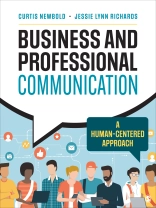Business and Professional Communication: A Human-Centered Approach, First Edition
prepares students to succeed in today’s workplace defined by changing technology, a diversifying workforce, and an increase in remote and hybrid work. Authors Curtis Newbold and Jessie Lynn Richards help students see that business communication is more than just a series of documents, meetings, and presentations – it’s a human-centered process that requires a holistic understanding of communication across modes and contexts. With accessibility and inclusion leading the way,
Business and Professional Communication
encourages students to be more conscientious, purposeful, and ethical in the way they communicate at work and beyond.
Mục lục
Part I: People – Communicating with Coworkers
Chapter 1: Understanding People: Communication, Empathy, and the Workplace Culture
The World is Changing-So Should the Way We Communicate
How Humans Think and Why This Matters at Work
Making Empathy and Inclusion a Top Priority
Organizational Culture and the Role of Communication
Chapter 2: Creating Meaningful Messages: Informing, Persuading, and Sharing Ideas at Work
Persuasive Workplace Communication: Assessing Purpose and Goals
Understanding Our Available Means
Appealing to Our Target Audiences
Creating Messages With Representation and Value
Making Ethical Choices
Part II: Modes – Mastering Communication Methods
Chapter 3 Interpersonal Communication: Verbal and Nonverbal
Interpersonal Communication in the Workplace
Verbal and Nonverbal Interactions in Workplace Environments
Listening and Responding to People′s Needs, Concerns, and Ideas
Interpersonal Collaboration and Inclusivity
Chapter 4 Written Communication
Writing as a Process: Prewriting, Writing, and Rewriting
Writing Inclusively for Diverse Audiences
Staying Organized With Structure in Mind
Working Toward Clarity, Simplicity, and Style-In That Order
Chapter 5 Visual Communication: Designing Information to be Clearer, More Engaging, and More User-centered
Why Visual Communication Is an Imperative Professional Skill
Designing Information to Be User Centered
Simplifying Content With Callouts and Tables
Visualizing Messages With Photos, Colors, Icons, and Charts
Branding, Design, and Your Company′s Image
Chapter 6 Digital Communication: Emerging Methods for Connecting With People
A New Era of Business Communication
Accessible Communication and the Role of Technology
Toggling Between Synchronous and Asynchronous Communication
Your Company′s Website and the Content Within
Social Media and Its Value at Work
Part III: Contexts – Adapting to Situations
Chapter 7: Day-to-day Conversations: Regular Messages between Co-workers
Routine Communication
The Channels We Choose to Connect Daily With Colleagues
Taking a Human-Centered Approach to Day-to-Day Communication
Requests, Replies, and Adjustments
Saving, Organizing, and Archiving Day-to-Day Messages
Chapter 8: Live Audience Deliveries: Presenting to Groups and Crowds
Importance of Live Presentations
Before You Present: Topic, Audience, Exigence, and Inclusion
Preparing Presentations: Purposes, Mediums, Types, and Methods
Creating the Presentation: Tools and Tips
When It′s Virtual: What Changes and What Doesn′t
Chapter 9: Informative Messages: Sharing, Reporting, Updating, and Storing
Delivering Information to Share, Update, and Report
Meeting Expectations: Informing People So They Know How to Plan
Using Alternative Methods for Sharing Information
Distributing and Archiving Informative Messages
Chapter 10: Requests and Propositions: Getting People on Board with Your Idea
How and When We Make Requests and Propose Ideas
Anticipating Audience Needs
Building Credibility Starts With Research
Presenting Your Message to Be Clear and Persuasive
Chapter 11: Collaborative Projects: Working in Teams
The Importance of Team Communication
Building a High-Functioning Team
Best Practices for Communicating in Teams
Teaming Communication Through Conflict
Collaborative Projects
Chapter 12: Leadership and Project Management: Guiding Others Toward Success
Communication′s Role in Leadership
Representing the Company as a Leader
Seven Leadership Styles Shaped by Communication
Leading Through Action and Language
Chapter 13: Client and Customer Interaction: Representing the Business
When You Communicate to Outside Stakeholders
Speaking to Customers for Different Reasons
Promoting Your Business to Potential Customers
Using Social Media to Engage With Audiences
Chapter 14: Education and Training: Sharing and Building Knowledge at Work
Learning, Teaching, and Professional Development: Your Roles and Responsibilities
Delivering Learner-Centered Trainings
Training People Through Written and Visual Instruction
Trainings Designed With Safety in Mind
Chapter 15: Career Communication: Researching, Applying, and Interviewing for a Job
Searching for a Job in a Changing World
Establishing Your Personal Brand and Visual Identity
Applying for the Job
Interviewing for the Job
Appendix A: Document Formatting Guide
Appendix B: Data Visualization Guide
Appendix C: Technology Guide: File Formats, Color Modes, and Fonts
Appendix D: Slide Deck Guide: Power Point Tips, Tricks, and Ideas.
Appendix F: Research Methods Guide
Giới thiệu về tác giả
Jessie Lynn Richards, Ph D., is an associate professor/lecturer in the Eccles School of Business at the University of Utah where she teaches interpersonal and organizational communication and writing. She has taught at the university level for over 18 years teaching various forms of business, professional, technical, and scientific communication at the undergraduate and graduate level. Richards has extensive experience in curriculum development, particularly in areas of business and professional communication. She has delivered communication “best practices” workshops for companies and organizations in Utah, California, New Jersey, and Nashville. Additionally, she has given Equity, Diversity and Inclusion (EDI) training at companies in Utah and for the Court-Appointed Special Advocates (CASA) of New Jersey. She has presented scholarly workshops and conferences at the Association of Business Communication and the National Communication Association. She is on the board of the Mc Cluskey Center for Violence Prevention at the University of Utah and also works with the University’s Gender-Based Violence Consortium. Her research focuses on intersections of trauma, gender, and language in organizational contexts. In 2015, Richards started Fight Against Domestic Violence (FADV), a non- profit foundation, to support survivors of domestic violence through business and individual partnerships. Jessie earned a Ph D in Communication from the University of Utah, an MA degree in Rhetoric and Writing Studies from San Diego State University, and a BS in English and Technical Writing from Utah State University.












